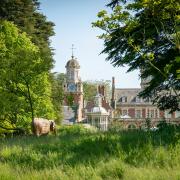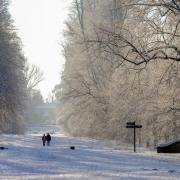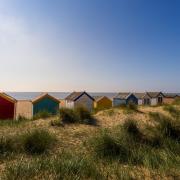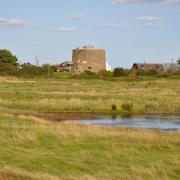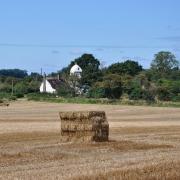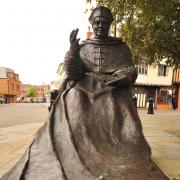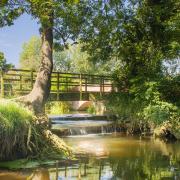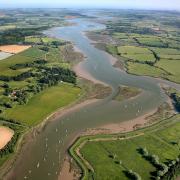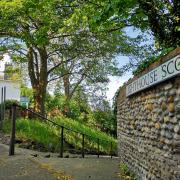Lindsay Want goes on a walking adventure around Somerleyton on the ancient island of Lothingland

Now come on me hearties, don't be lily-livered about getting out there in the fresh winter air. If one Suffolk walk ever warranted pulling on those long-johns and reaching for that silver thread base-layer, then it has to be this one.
Whether you're an ardent land-lubber or old sea-dog, you'll love sailing the Wherry Line up beyond Oulton Broad from Lowestoft central.
As railway journeys go, it's an unusual little voyage, snatching bright beacon-flashes of the Waveney as the lazy river bends and basks beneath the new year's early sun.
Out on the marshes, the lingering drifts of mist are spine-chillingly beautiful. But before you can say 'shiver me timbers', it's time to disembark at Somerleyton station and set booted foot on East Anglia's ancient island of Lothingland.

But before you thread your way through the frosty boatyard towards Slug's Lane, reach for the OS map and you'll realise you're heading out into mysteriously uncharted territory. There's simply no mention of Lothingland on the maps and no clue to the past, other than Lowestoft's Lake Lothing, perhaps.
In ancient times, the 'island' was bound to the north by the River Yare and Breydon Water, and to the west and south by the Waveney which flowed towards the sea through Oulton Broad.
Today, it's almost as if it has disappeared without a trace, leaving little more than haunting memories of Neolithic settlers and Norsemen amid a modern landscape shaped by energetic entrepreneurs.
On Somerleyton's idyllic horseshoe shaped green, in the company of picture-perfect Victorian estate cottages and the thatched primary school, a wild, war-like Viking on the village sign looks distinctly at sea.

He's a Sumelinda, explains the helpful plaque below, a plundering sailor or pirate who had presumably made his way up the Waveney in search of booty and apparently liked what he found enough to want to stay.
The Domesday Book's name for Somerleyton, Sumeledetuna, it tells us, translates as Pirates Farm.
Judging from the lofty obelisk crowned with some strange craft, just metres away, you'd think a UFO must have landed here too, but it turns out to honour the endeavours of a later settler in these parts, Christopher Cockerill who ran the commercial boatyard and ended up inventing the hovercraft in 1955.
Time to circumnavigate Somerleyton's stately home and parkland centrepiece, and reflect upon other local settlers as you dip in and out of the Angles Way.

After the Jernagen family established the Jacobean mansion, the hall at Pirates Farm attracted other interesting owners, such as Lowestoft lad and renowned privateer Admiral Sir Thomas Allin, and the rather worryingly named Anguish family.
Builder extraordinaire and railway pioneer Sir Samuel Morton-Peto remodelled the mansion in amazing Anglo-Italianate style in 1844, and created chocolate-box estate houses such as Lodge Cottage.
That is, when he wasn't constructing the Broadlands railway route and Somerleyton's swing-bridge, Lowestoft's resort and 1,000-boat harbour, 750 miles of railway lines in the UK and 2,300 miles in Canada, Russia and Australia, and ensuring that his local enterprise could supply bricks to build Nelson's Column, Liverpool Street Station and even the Houses of Parliament.
For Peto, it was the excellent brick-making clay which was Somerleyton's buried treasure. Eventually though, like many an entrepreneur of his day, Peto went bust and, in 1866, sold the Somerleyton estate to the Crossleys of carpet manufacturing fame whose family holds the hall to this day.

Along the wide field-margin path, past vintage oaks and purple-tipped hedgerows, to the isolated church beached on the out-stretched banks of farmland near Ashby.
It was beyond the medieval crossroads, down near The Dell on this side of 16th century Fritton Decoy Lake, just a decade or so before Peto set about his Somerleyton grand plans, that one of the Island of Lothingland's real hidden treasures was discovered, an Anglo-Saxon ship burial, 54ft long with a 47ft keel.
Back on track, it's a bit unnerving that the only route between lonely Ashby church and civilization goes under the name of Snakes Lane. The ancient trackway writhes round into Lound by the manor house fish pond, known locally as 'the Mardle', where the chap on the village sign seems to be casting food to a live audience of coots, moorhens and ducks.
It's a picturesque find, but a wiggly footpath later, if you dare to push open the church door, visit Lound's church of St John the Baptist and you've really struck gold.

Sir John Betjeman, in his film on East Anglian churches, declared that Lound really steals the show.
From Cavendish to Barsham and Norfolk's Wymondham Abbey, East Anglia is peppered with grains of golden handiwork courtesy of the early 20th century 'restorer' Sir Ninian Comper, but here from towering font cover to ornate organ and exquisite rood screen, every piece is sheer medieval make-believe and all that glitters is definitely gilded in gold.
It's an amazing treasure trove and the memory will stay with you every step of the way, past Earth Lane and Town Pits, and down Green Lane where Somerleyton Hall's loggia tower pokes its head above the paddocks.
Past Summerhouse Water, both the River Waveney and the tiny windows of a distant train shuttling down the track by the edge of Blundeston Marshes catch the day's lowering rays with an unexpected sparkle. Rejoining the Angles Way as you take a gander down Waddling Lane, there are some unexpected stars - and stripes - too.

The poignant monument to US Airmen killed here in a 1944 plane crash echoes similar USAAF tragedies recorded on another wayside memorial back near Ashby's lonely church.
There, touching tales tell how a group of Yarmouth Sea Scouts, daring to explore Pirates Farm on a midnight hike, came across it in the middle of nowhere.
They put an X to mark the spot on their map and returned the next day to play the Last Post. Generations of Sea Scouts have since returned to that cross every Remembrance Sunday.
Take a walk on the secret Island of Lothingland, and you'll find yourself taking away the most precious treasure of all - memories.

THE WALK
1) From Somerleyton railway station, head up lane to junction. Go straight over, following footpath sign. Shortly, at Angles Way marker, turn left through trees to boatyard. Keep following markers right through boatyard, past Somerleyton Marina, to exit up roadway beneath Brickworks Terrace.
2) Turn left at road. Pass Duke's Head pub, continuing up road to footpath (right). Path leads across a field. Turn right after hedge, to meet The Street (Somerleyton).
3) Turn left to reach road junction by the Green (hovercraft memorial - right). Keep left along the pavement past village green, sign and primary school. At sharp bend take the Ashby road (right), then go right, following the red sign for 'Somerleyton Hall & Gardens - Coaches / Pedestrians'. Walk past thatched lodge cottage, down driveway.

4) Turn left onto field edge footpath. (If you reach a house or brick wall with ornamental urns at corners, you have gone too far!) Continue straight ahead over the farm track to reach St Mary's Ashby.
5) The USAAF memorial here is field-side by the churchyard fence. Just beyond St Mary's, turn right onto Snakes Lane. This leads all the way to Lound, arriving by the pub and pond.
6) Turn right along road. By the green (left) take footpath left past cottages. At Nether End Cottage, turn right to reach church.
7) As well as styling the interior at St John the Baptist Lound, Sir Ninian Comper also created the WWI memorial outside near the front of the church. Exit churchyard onto road. Turn right, past the community green to junction. Turn left. Opposite the Rectory (left) turn right into Green Lane, noting the unusual buildings at Park Farm and views across the fields towards the tower of Somerleyton Hall .

8) Just before the B1074 junction, take footpath left to cut off the corner. At the gap in wall, cross B1074 to enter field via a tall style. The field-edge path leads to gate to 'Waddling Lane' (track). Turn right.
9) The WWII USAAF memorial is on the left. Follow the green lane and at junction of paths (Wicker Well), keep straight ahead, through Wadding Wood, following signs for Angles Way.
10) When track bears right, detour left to view unusual brick animal pound and glimpse marshland vistas. Retrace steps to continue straight ahead uphill to meet Station Road at Waveney Grange Farm. Turn left to return to railway station.
Compass points
Distance: 7.5 miles (12 kms)
Time: 3 hours
Start: Somerleyton Railway Station (NR32 5QN)
Getting there: nationalrail.co.uk, suffolkonboard.com. Free parking at Somerleyton Station or street parking near point 3 (start circular walk from there).
Access: Green lanes, wooded footpaths, field margin paths, some tarmac roads or pavements. Flat or gentle inclines. Stiles, gates.
Big map: OL Outdoor Leisure 40
Ts & Ps: Pubs at Lound and Somerleyton.




